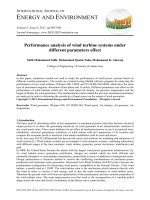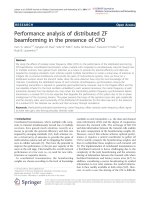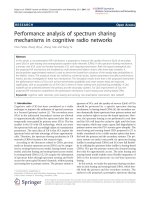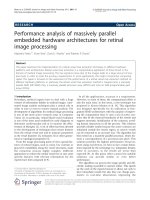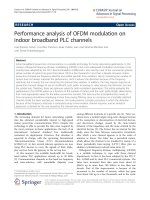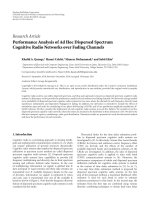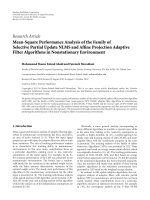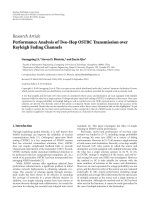Transient performance analysis of a single server queuing model with retention of reneging customers
Bạn đang xem bản rút gọn của tài liệu. Xem và tải ngay bản đầy đủ của tài liệu tại đây (324.77 KB, 17 trang )
Yugoslav Journal of Operations Research
28 (2018), Number 3, 315–331
DOI: />
TRANSIENT PERFORMANCE ANALYSIS OF
A SINGLE SERVER QUEUING MODEL WITH
RETENTION OF RENEGING CUSTOMERS
Rakesh KUMAR
Department of Mathematics,
Shri Mata Vaishno Devi University, Katra
Jammu and Kashmir, India
rakesh stat
Sapana SHARMA
Department of Mathematics,
Shri Mata Vaishno Devi University, Katra
Jammu and Kashmir, India
Received: April 2017 / Accepted: February 2018
Abstract: In this paper, we study a single server queuing model with retention of
reneging customers. The transient solution of the model is derived using probability
generating function technique. The time-dependent mean and variance of the model
are also obtained. Some important special cases of the model are derived and discussed.
Finally, based on the numerical example, the transient performance analysis of the model
is performed.
Keywords: Transient Performance Analysis, Mean and Variance, Probability Generating Function, Reneging, Probability of Customers’ Retention.
MSC: 60K25, 68M20.
1. INTRODUCTION
Queuing systems with customers’ impatience are used in modeling and analysis
of a wide variety of real situations, for example, computer networks with packet
loss, perishable inventory systems, call centres, hospital emergency rooms handling
316
Kumar, R., and Sharma, S., / Transient Performance Analysis
critical patients, and impatient telephone switchboard customers. Customers’ impatience in queuing theory is extensively discussed by many researchers in terms of
reneging and balking. The tendency of a customer not to join a queue upon arrival
is called balking while in reneging, a customer joins the queue, waits for some time
and leaves the queue without getting service if the wait is more than his expected
wait. The pioneer researchers in the area of queuing with balking and reneging are
Haight [6], [7], Ancker and Gaffarian [4], [3], Obert [13], and Subba Rao [18], [19].
They come out with basic queuing models with balking and reneging concepts.
Since then, these ideas are exploited to a great extent and a number of generalizations are made. Yechiali [27] studies customers’ impatience in Markovian queuing
systems with disaster and repair. He performs the steady-state analysis of these
models. Sudhesh [20] derives the time-dependent solution of a single server Markovian queue with disaster and repairs. Kumar [9] studies a correlated input queuing
system with catastrophic and restorative effects facing customers’ impatience. He
derives the transient solution of the model. Vijaya Laxmi et al. [22] study a
finite buffer multiple vacation queue with balking, reneging and vacation interruption under N-policy. They further carry out the cost analysis of the model using
swarm optimization and quadratic fit research methods. Vijaya Laxmi and Jyothsna [23] study a single server queue under variant working vacation policy with
reneging and balking. Ammar [1] obtains the time-dependent solution of a twoheterogenous servers queue with impatient customers using probability generating
function. Vijaya Laxmi and Jyothsna [24] study a renewal input multiple vacations queuing model with balking, reneging and heterogenous servers. They use
supplementary variable and recursive techniques to obtain the steady-state probabilities of the model. Goswami [5] derives the study-state solution of the renewal
input finite buffer queuing model with balking reneging and multiple working vacation using supplementary technique. Vijaya Laxmi and Jyothsna [25] consider an
M/M/1 queue with working vacations, bernoulli schedule vacation interruption,
balking and reneging. They obtain the steady-state probabilities using generating
function. Ammar [2] studies an M/M/1 queue with customers’impatience and
multiple vacations. Sudhesh et al. [21] perform the time-dependent analysis of
two-heterogenous servers queue with disaster, repair and customers’ impatience.
They discuss the steady-state results of the model also. Rykov [15] studied several
monotonicity properties of optimal policies for a multi-server controllable queuing
systems with heterogeneous servers. Koba and Kovalenko [8] studied three retrial
queuing systems in terms of aircraft landing process. Rykov [16] generalized the
slow server problem for the case of additional cost structure and showed that the
optimal policy for the problem has a monotone property.
Customers’ impatience leads to the loss of potential customers and therefore,
it is a serious problem to any firm. If the firms use certain customer retention
strategies, then there is a probability that a reneging customer may be retained
for his further service. Kumar and Sharma [11] take this idea into account and
study a finite capacity single server Markovian queuing system with retention of
reneging customers. They obtain the steady-state solution of the model using
iterative method. The sensitivity analysis of the model is also performed. Kumar
Kumar, R., and Sharma, S., / Transient Performance Analysis
317
and Sharma [12] obtain the steady-state solution of a Markovian single server
queueing system with discouraged arrivals and retention of reneging customers
by using iterative method. Kumar [10] extends this idea to the finite capacity
multi-server Markovian queue and performs the cost-profit analysis of the model.
The steady-state results do not reveal the real picture of the system under
consideration, because the transient and start up effects are not taken care of,
Whitt [26]. In most of the applications of the queuing theory, the modelers need
to know how the system will operate up to some time instant t. Furthermore, if
the system is empty initially, the fraction of time the server is busy and the initial
rate of output will be below the steady-state values. Therefore, the steady-state
analysis is not sufficient. Thus, in this paper we undertake the transient analysis of
a single server queuing system with reneging and retention of reneging customers.
The queuing system studied in this paper finds its application in modeling
the computer communication networks with frame loss, Sharma et. al [17]. In a
data communication network, each frame waits for a certain length of time for its
transmission at a router. If the transmission does not begin by then, the frame
may get lost. The lost frames can be considered as reneged customers in queuing
terminology. There are probable chances that a lost frame may be traced by a
tracer. The traced frame can be considered as a retained customer.
Rest of the paper is structured as follows: in section 2, the queuing model is
described. In section 3, the transient solution of the model is obtained. Section
4 deals with the computation of mean and variance. Special cases of the model
are discussed in section 5, and in section 6 the numerical example is presented.
Finally, the paper is concluded in section 7.
2. QUEUING MODEL
We consider a single server queuing model with retention of reneging customers in
which the customers arrive according to a Poisson process with mean rate λ. The
service time distribution is negative exponential with parameter µ. The queue
discipline is first-come-first-served (FCFS). The capacity of the system is infinite.
After joining the queue, each customer will wait for a certain length of time T for
his service to begin. If it does not begin by then, he may get renege with probability p and may remain in the queue for his service with probability q(= 1 − p)
if certain customer retention strategy is used. The time T is a random variable
which is assumed to follow negative exponential distribution with parameter ξ. It
is further assumed that the reneging can only occur if the number of customers
in the system are greater than a certain threshold value k. Therefore, the average
reneging rate is given by the following function:
ξn =
0,
0
Let {X(t), t ≥ 0} be the number of customers in the system at time t. Let
Pn (t) = P {X(t) = n}, n = 0, 1, ... be the probability that there are n customers in
318
Kumar, R., and Sharma, S., / Transient Performance Analysis
the system at time t, and P (z, t) the corresponding probability generating function.
We assume that there is no customer in the system at t = 0.
The queuing model under investigation is governed by the following set of
differential-difference equations:
dP0 (t)
= −λP0 (t) + µP1 (t),
dt
(1)
dPn (t)
= − (λ + µ) Pn (t) + λPn−1 (t) + µPn+1 (t); n = 1, 2, . . . , k − 1,
dt
(2)
dPk (t)
= − (λ + µ) Pk (t) + λPk−1 (t) + (µ + ξp)Pk+1 (t); n = k,
dt
(3)
dPn (t)
dt
= − (λ + µ + (n − k)ξp) Pn (t) + λPn−1 (t) +
(µ + (n − k + 1)ξp)Pn+1 (t); n = k + 1, . . .
(4)
3. TRANSIENT SOLUTION OF THE MODEL
In this section, we derive the transient solution of the model. We use the probability generating function technique to obtain the time-dependent system size
probabilities.
Theorem 1. The time-dependent probabilities of the system size of a single server
queuing model with retention of reneging customers that is governed by the differentialdifference equations (1) − (4) are given by:
t
Pi (t)
bi,k−2 (u)Pk−1 (t − u)du, i = 0, 1, . . . , k − 2,
= bi,0 (t) + µ
0
∞
Pk−1 (t)
n
(−1)m
Ψ
m=0
=
n=0
u
µ
Ψ
m
2Ψ
α
n+1
(n + 1)
E C(m) (u − v) exp{−(λ + µ − ξp)v}
0
n
m
t
D(t − u)
0
In+1 (αv)
dudv ,
v
and, for n = 1, 2, . . .
t
Pn+k−1 (t) = nγ n
exp{−(λ + µ − ξp)(t − u)}
0
In (α(t − u))
Pk−1 (u)du.
(t − u)
where Ψ = µ − ξp, α = 2 λ(µ − ξp), E C(m) (t) is m-fold convolution of E(t)
with itself with E C(0) = δ(t), δ(t) is the Dirac delta function, In (.) is the modified
Bessel function of first kind and D(t − u) is a function of u at a particular value
of t, obtained from the convolution of two functions E(t) and D(t), where E(t) =
L−1 (E ∗ (s)) and D(t) = L−1 (D∗ (s)).
Kumar, R., and Sharma, S., / Transient Performance Analysis
319
Proof. Define the probability generating function P (z, t) for the transient state
probabilities Pn (t) by
∞
k−1
P (z, t) =
Pn+k (t)z n+1 ; P (z, 0) = 1
Pn (t) +
n=0
(5)
n=0
with
k−1
Pn (t) = Qk−1 (t).
(6)
n=0
Adding the equations (1) and (2), we get
d(Qk−1 (t))
= −λPk−1 (t) + µPk (t).
dt
(7)
Now, multiplying the equation (3) and (4) by z n , summing over the respective
range of n, we obtain
∞
Pn+k (t)z n+1
d
∞
n=0
=
dt
[(µ − ξp)(z −1 − 1) + λ(z − 1)]
Pn+k (t)z n+1
n=0
∂P (z, t)
. (8)
∂z
Adding the equations (7) and (8) , we obtain the following partial differential
equation
+λzPk−1 (t) − µPk (t) + ξp(1 − z)
∂P (z, t)
∂P (z, t)
− ξp(1 − z)
∂t
∂z
=
[(µ − ξp)(z −1 − 1) + λ(z − 1)]
[P (z, t) − Qk−1 (t)] + λ(z − 1)Pk−1 (t).(9)
Solving the equation (9), we get
t
P (z, t)
=
exp [(µ − ξp)(z −1 − 1) + λ(z − 1)]t +
[λ(z − 1)Pk−1 (u) −
0
((µ − ξp)(z −1 − 1) + λ(z − 1))Qk−1 (u)] × exp [(µ − ξp)(z −1 − 1)+
λ(z − 1)](t − u)} du.
(10)
λ
µ−ξp ,
If α = 2 λ(µ − ξp) and γ =
then using the modified Bessel function of
first kind In (.) and the Bessel function properties, we get
exp
λz +
µ − ξp
z
∞
t
(γz)n In (αt),
=
n=−∞
(11)
320
Kumar, R., and Sharma, S., / Transient Performance Analysis
Using (11) in (10), we get
∞
P (z, t)
exp{[−(λ + µ − ξp)]t}
=
(γz)n In (αt)
n=−∞
t
Pk−1 (u) exp{[−(λ + µ − ξp)](t − u)}
+λ
0
∞
(γz)n [γ −1 In−1 (α(t − u)) − In (α(t − u))]du
×
n=−∞
t
Qk−1 (u) exp{[−(λ + µ − ξp)](t − u)}
+
(12)
0
∞
(γz)n [−λγ −1 In−1 (α(t − u))
×
n=−∞
+(λ + µ − ξp)In (α(t − u)) − (µ − ξp)γIn+1 (α(t − u))]du.
Now, comparing the coefficients of z n on either side of (12), we obtain for n =
1, 2, . . .
t
Pn+k−1 (t)
=
exp{−(λ + µ − ξp)t}γ n In (αt) + λ
exp{−(λ + µ − ξp)(t − u)}
0
× In−1 (α(t − u))γ n−1 − In (α(t − u))γ n Pk−1 (u)du
t
exp{−(λ + µ − ξp)(t − u)}Qk−1 (u)[λIn−1 (α(t − u))γ n−1
−
0
−(λ + µ − ξp)In (α(t − u))γ n + (µ − ξp)In+1 (α(t − u))γ n+1 ]du,
(13)
Comparing the terms free of z on either side of equation (12), that is, for n = 0,
we get
t
Qk−1 (t)
=
exp{−(λ + µ − ξp)t}I0 (αt) + λ
exp{−(λ + µ − ξp)(t − u)}
0
Pk−1 (u) × I1 (α(t − u))γ −1 − I0 (α(t − u)) du −
t
exp{−((λ + µ − ξp))(t − u)}Qk−1 (u) × [αI1 (α(t − u))−
0
(λ + µ − ξp)I0 (α(t − u))] du.
(14)
As P (z, t) does not contain terms with negative powers of z, the right hand side
of (13) with n replaced by −n must be zero. Thus, we obtain
t
exp{−(λ + µ − ξp)(t − u)}Qk−1 (u)[λIn+1 (α(t − u))γ n−1 −
0
(λ + µ − ξp)In (α(t − u))γ n + (µ − ξp)In−1 (α(t − u))γ n+1 ]du,
Kumar, R., and Sharma, S., / Transient Performance Analysis
321
t
=
exp{−(λ + µ − ξp)t}In (αt)γ n + λ
exp{−(λ + µ − ξp)(t − u)}Pk−1 (u)
0
×[In+1 (α(t − u))γ n−1 − In (α(t − u))γ n ]du,
(15)
The usage of (15) in (13) considerably simplifies the working and results in a
elegant expression for Pn (t). This yields, for n = 1, 2, . . .
t
Pn+k−1 (t) = nγ n
exp{−(λ + µ − ξp)(t − u)}
0
In (α(t − u))
Pk−1 (u)du. (16)
(t − u)
The remaining probabilities Pn (t), n = 0, 1, . . . , k−1 can be obtained by solving
the equations (1) and (2). In matrix form, the equations (1) and (2) can be written
as:
dP(t)
= AP(t) + µPk−1 (t)ek−1
dt
(17)
where the matrix A = (ai,j )k−1×k−1 is given
−(λ)
µ
λ
−(λ
+ µ)
A= .
.
..
..
0
0
as:
···
···
..
.
0
0
..
.
···
−(λ + µ)
P(t) = (P0 (t) P1 (t) . . . Pk−2 (t))T , ek−1 = (0 0 . . . 1)T is column vector of
order k − 1.
∗
Let P∗ (s) = (P0∗ (s) P1∗ (s) . . . Pk−2
(s))T denote the Laplace transform of
P(t). Taking the Laplace transform of equation (17) and solving for P∗ (s), we get
∗
P∗ (s) = (sI − A)−1 {µPk−1
(s)ek−1 + P(0)},
(18)
∗
with P(0) = (1 0 . . . 0)T . Thus, only Pk−1
(s) remains to be found. We observe
T
that if e = (1 1 . . . 1)k−1×1 , then
∗
eT P∗ (s) + Pk−1
(s) = Q∗k−1 (s),
(19)
where Q∗k−1 (s) is the Laplace inverse of Qk−1 (t). Define,
φ(s) = (s + λ + (µ − ξp)) −
(s + λ + (µ − ξp))2 − α2 .
Taking Laplace transform of (14) and solving for Q∗k−1 (s), we obtain
∗
sQ∗k−1 (s) = 1 + Pk−1
(s)
1
{φ(s)} − λ
2
(20)
322
Kumar, R., and Sharma, S., / Transient Performance Analysis
Using equations (20) in (19) and simplifying, we get
∗
Pk−1
=
1 − seT (sI − A)−1 P(0)
.
{(s + λ) − 21 [φ(s)] + µseT (sI − A)−1 ek−1 }
(21)
In equations (18) and (21), (sI − A)−1 has to be found. Let us assume that
(sI − A)−1
(b∗ij (s))k−1×k−1
=
where b∗ij (s) is the Laplace inverse of bij (t). We note that (sI − A)−1 is almost
lower triangular. Following Raju and Bhat [14], we obtain for i = 0, 1, . . . , k − 2
b∗ij (s) =
1
µ
ui,0 (s)
uk−1,0 (s) ,
uk−1,j+1 (s)ui,0 (s)−ui,j+1 (s)uk−1,0 (s)
uk−1,0 (s)
,
j = 0, 1, . . . , k − 3,
(22)
j = k − 2,
where ui,j (s) are recursively given as
i = 0, 1, . . . , k − 2;
ui,i (s) = 1,
ui+1,i (s) =
s+λ+µ
,
µ
ui+1,i−j (s) =
uk−1,j (s) =
i = 0, 1, . . . , k − 3;
(s+λ+µ)ui,i−j −λui−1,i−j
,
µ
j ≤ i, i = 1, 2, 3, . . . , k − 3;
[s + λ + µ]uk−2,j − λuk−3,j ,
j = 0, 1, . . . , k − 3;
(23)
j =k−2
s + λ + µ,
and
ui,j (s) = 0, for other i and j. We have suppressed the argument s to facilitate
computation. The advantage in using these relations is that we do not evaluate
any determinant. Using these in equation (21), we get
∗
Pk−1
(s) =
{1 − s
{(s + λ) − 12 [φ(s)]
k−2 ∗
i=0 bi,0 (s)}
,
k−2
+ µs i=0 b∗i,k−2 (s)}
(24)
and for i = 0, 1, . . . , k − 2 from equation (18), we get
∗
Pi∗ (s) = b∗i,0 (s) + µb∗i,k−2 (s)Pk−1
(s).
(25)
We observe that b∗i,j (s) are all rational algebraic functions in s. The cofactor of
the (i, j)th element of (sI − A) is a polynomial of degree k − 2− | i − j |. Since
the characteristic roots of A are all distinct, the inverse transform bi,j (t) of b∗i,j (s)
can be obtained by partial fraction decomposition. Let si , i = 0, 1, . . . , k − 2, be
323
Kumar, R., and Sharma, S., / Transient Performance Analysis
the characteristic roots of the matrix A. Then after partial fraction decomposition
∗
and simplification, Pk−1
(s) equals to
D∗ (s)
1
2 [φ(s)]
1−
,
µ
2(µ−ξp)(1− µ−ξp
E ∗ (s))
(s+λ+µ−ξp)−
√
(26)
(s+λ+µ−ξp)2 −α2
where
k−2
D∗ (s) =
Dm
,
s − sm
m=0
(27)
k−2
∗
E (s) =
Em
.
s
−
sm
m=0
(28)
with constants Dm and Em given by
k−2
sb∗l,0 (s)
(29)
sb∗l,k−2 (s) .
(30)
Dm = lim (s − sm ) 1 −
s→sm
l=0
k−2
Em = lim (s − sm )
s→sm
l=0
Hence, (26) simplifies into
∞
∗
Pk−1
(s)
=
n=0
×
n
(−1)m
Ψ
m=0
2Ψ
α
n+1
(n + 1)
n
m
µ
Ψ
m
D∗ (s)(E ∗ (s))m
[(s + λ + µ − ξp) − (s + λ + µ − ξp)2 − α2 ]n+1
,
(n + 1)αn+1
(31)
where Ψ = (µ − ξp).
Taking Laplace inverse of (31), we obtain
∞
Pk−1 (t)
=
n=0
u
n
(−1)m
Ψ
m=0
2Ψ
α
n+1
µ
Ψ
m
(n + 1)
E C(m) (u − v) exp{−(λ + µ − ξp)v}
0
n
m
t
D(t − u)
0
In+1 (αv)
dudv , (32)
v
C(m)
where E
(t) is m-fold convolution of E(t) with itself with E C(0) = δ(t). Now,
the Laplace inverse of equation (25) yields,
t
bi,k−2 (u)Pk−1 (t − u)du, i = 0, 1, . . . , k − 2,
Pi (t) = bi,0 (t) + µ
(33)
0
where Pk−1 (u) is given by (32). Therefore, all the transient-state probabilities are
obtained explicitly in (16), (32), and (33).
324
Kumar, R., and Sharma, S., / Transient Performance Analysis
4. MEAN AND VARIANCE
This section deals with the derivation of time-dependent mean and variance of the
system.
4.1 MEAN, M (t)
The mean number of customers in the system at time t is given by
∞
k
M (t) = E(X(t))
=
nPn (t) +
n=1
nPn (t),
(34)
n=k+1
and
∞
k
M (t)
=
nPn (t) +
n=1
nPn (t).
(35)
n=k+1
From equations (2), (3) and (4) after considerable mathematical simplification,
the above equation will lead to the following differential equation
∞
M (t)
−(λ + µ)M (t) + λ
=
∞
nPn−1 (t) + µ
n=1
nPn+1 (t) +
n=1
∞
∞
n(n − k)(Pn+1 (t) − Pn (t)) +
ξp
n=k+1
nPn+1 (t) .
(36)
n=k
Therefore,
∞
M (t)
= λ
∞
t
Pn−1 (u) exp{−(λ + µ)(t − u)}du + µ
n
n=1
0
n=1
t
∞
n(n − k)
exp{−(λ + µ)(t − u)}du + ξp
exp{−(λ + µ)(t − u)}du.
(Pn+1 (u) − Pn (u))
t
Pn+1 (u) ×
n
n=k
Pn+1 (u)
0
0
n=k+1
∞
exp{−(λ + µ)(t − u)}du + ξp
t
n
0
(37)
where Pn (t) for n = 0, 1, ..., k − 2; Pk−1 (t) and Pn+k−1 (t) for n = 1, 2, ... are given
in equations (16), (32), and (33) respectively.
325
Kumar, R., and Sharma, S., / Transient Performance Analysis
4.2 VARIANCE, V(X(t))
The variance of number of customers in the system at time t is given by:
= E(X 2 (t)) − [E(X(t))]2
V (X(t))
= K(t) − [M (t)]2
∞
2
∞
2
n Pn (t) −
=
nPn (t)
n=1
.
(38)
n=1
where K(t) = [E(X 2 (t))]. From equations (2), (3), and (4) after considerable
mathematical simplification, the above equation will lead to the following differential equation
∞
K (t)
= −(λ + µ)K(t) + λ
∞
n2 Pn−1 (t) + µ
n=1
n2 Pn+1 (t) +
n=1
∞
∞
n2 Pn+1 (t) .
n2 (n − k)(Pn+1 (t) − Pn (t)) +
ξp
(39)
n=k
n=k+1
Therefore,
∞
K(t)
n
= λ
∞
t
2
0
n=1
n=1
t
∞
n2 (n − k)
exp{−(λ + µ)(t − u)}du + ξp
Pn+1 (u)
0
(Pn+1 (u) − Pn (u))
0
n=k+1
∞
2
exp{−(λ + µ)(t − u)}du + ξp
t
n2
Pn−1 (u) exp{−(λ + µ)(t − u)}du + µ
t
Pn+1 (u) ×
n
0
n=k
exp{−(λ + µ)(t − u)}du.
(40)
Substituting the above equation in (38), we get
∞
V (X(t))
n=1
∞
t
n2
= λ
Pn−1 (u) exp{−(λ + µ)(t − u)}du + µ
0
n=1
t
∞
n2 (n − k)
exp{−(λ + µ)(t − u)}du + ξp
(t − u)] du − [M (t)]2 .
(Pn+1 (u) − Pn (u))
t
n
n=k
Pn+1 (u)
0
0
n=k+1
∞
2
exp{−(λ + µ)(t − u)}du + ξp
t
n2
Pn+1 (u) exp [−(λ + µ)
0
(41)
where Pn (t) for n = 0, 1, ..., k − 2; Pk−1 (t); Pn+k−1 (t) for n = 1, 2, ... and M (t) are
given in equations (16), (32), (33), and (37), respectively.
326
Kumar, R., and Sharma, S., / Transient Performance Analysis
5. SPECIAL CASES OF THE MODEL
Case 1 When q = 0, i.e. when the retention mechanism is absent. The model
reduces to a single server queuing model with reneging having system size probabilities as given below:
t
Pn+k−1 (t)
=
nγ1n
exp{−((λ + µ − ξ))(t − u)}
0
∞
Pk−1 (t)
n
=
n=0
u
(−1)m
Ψ
m=0
n+1
2Ψ
α1
µ
Ψ
In (α1 (t − u))
Pk−1 (u)du,
(t − u)
n = 1, 2, . . .
(42)
m
n
m
(n + 1)
E C(m) (u − v) exp{−(λ + µ − ξ)v}
0
t
D(t − u)
0
In+1 (α1 v)
dudv , (43)
v
t
bi,k−2 (u)Pk−1 (t − u)du, i = 0, 1, . . . , k − 2.
Pi (t) = bi,0 (t) + µ
(44)
0
λ
µ−ξ ,
where α1 = 2 λ(µ − ξ) ,γ1 =
and Ψ = (µ − ξ).
Case 2 When there is no reneging, the queuing system reduces to the one having
probabilities as under:
t
Pn+k−1 (t) = nγ2n
exp{−(λ+µ)(t−u)}
0
∞
Pk−1 (t)
=
n=0
u
n
(−1)m
µ
m=0
2µ
α2
In (α2 (t − u))
Pk−1 (u)du,
(t − u)
n+1
(n + 1)
E C(m) (u − v) exp{−(λ + µ)v}
0
n
m
n = 1, 2, . . .
t
D(t − u)
0
In+1 (α2 v)
dudv ,
v
(45)
t
bi,k−2 (u)Pk−1 (t − u)du, i = 0, 1, . . . , k − 2.
Pi (t) = bi,0 (t) + µ
0
√
where α2 = 2 λµ and γ2 =
λ
µ.
(46)
Kumar, R., and Sharma, S., / Transient Performance Analysis
327
6. A NUMERICAL EXAMPLE FOR TRANSIENT
PERFORMANCE ANALYSIS
In this section, the transient performance analysis of the model is carried out
on a numerical example. We present and analyze some important measures of
performance, such as average reneging rate at time t (denoted by Rr (t)), and
average retention rate at time t (denoted by RR (t)). The expressions for Rr (t)
and RR (t) are as follows:
6.1. Average Reneging Rate
∞
Rr (t)
(n − k)ξpPn (t)
=
n=k
6.2. Average Retention Rate
∞
RR (t)
(n − k)ξqPn (t)
=
n=k
where Pn (t) is provided in equations (16), (32), and (33).
We use MATLAB software to compute the numerical results. All numerical
results are presented in Figures 1-4. From these figures, following observations can
be made:
1. Fig. 1 shows the effect of the probability of retaining a reneging customer on the
expected system size in transient state. One can observe that as the probability of
retaining a reneging customer increases, the expected system size also increases.
This establishes the role of probability of retention associated with any customer
retention strategy.
2. In Fig. 2 the change in average reneging rate with the change in probability of
retention is shown in transient state. We can observe that there is a proportional
decrease in average reneging rate with the increase in probability of retention, q.
3. The average retention rate increases as the probability of retaining a reneging
customer (q) increases. This is evident from Fig. 3 which justifies the functioning
of the model.
4. Fig. 4 shows a relative change in time-dependent probabilities of system size
with time. One can see that with the passage of time the system attains a steadystate.
328
Kumar, R., and Sharma, S., / Transient Performance Analysis
Figure 1: The expected system sizes versus probability of retention (q) are plotted for the case
λ = 2, µ = 3, t = 0.5, k = 2, ξ = 0.1 and q = 0.1, 0.2, . . . , 0.9
Figure 2: Variation of average reneging rate with the variation in probability of retention for the
case λ = 2, µ = 3, t = 0.5, k = 2, ξ = 0.1 and q = 0.1, 0.2, . . . , 0.9
Kumar, R., and Sharma, S., / Transient Performance Analysis
329
Figure 3: Variation of average retention rate with the variation in probability of retention for
the case λ = 2, µ = 3, t = 0.5, k = 2, ξ = 0.1 and q = 0.1, 0.2, . . . , 0.9
Figure 4: The probabilities versus time are plotted for the case λ = 2, µ = 3, ξ = 0.1, k = 2 and
q = 0.4
330
Kumar, R., and Sharma, S., / Transient Performance Analysis
7. CONCLUSIONS
The transient performance analysis of a single server queuing model with reneging
and retention of reneging customers is carried out. The explicit expressions for
mean and variance are obtained. The analysis carried out in this paper may be useful in the study of computer communication networks with loss of frames/packets.
Acknowledgement:The authors would like to thank the anonymous referees
for their constructive comments which helped to bring this paper in the current
form. One of the authors (Dr. Rakesh Kumar) would like to thank the UGC, New
Delhi, India for financial support given to him for the preparation of this paper.
REFERENCES
[1] Ammar, S. I., “Transient analysis of a two-heterogeneous servers queue with impatient
behavior”, Journal of the Egyptian Mathematical Society, 22 (2014) 90-95.
[2] Ammar, S. I., “Transient analysis of M/M/1 queue with impatient behavior and multiple
vacations”, Applied Mathematics and Computation, 260 (2015) 97-105.
[3] Ancker, C.J. and Gafarian, A.V., “Some queuing problems with balking and reneging I”,
Operations Research, 11 (1963a) 88-100.
[4] Ancker, C.J. and Gafarian, A.V., “Some queuing problems with balking and reneging II”,
Operations Research, 11 (1963b) 928-937.
[5] Goswami, V., “Study of customers’ impatience in a GI/M/1/N queue with working vacations”, International Journal of Management Science and Engineering Management, 10
(2015) 144-154.
[6] Haight, F. A., “Queuing with balking I”, Biometrika, 44 (1957) 360-369.
[7] Haight, F. A., “Queuing with reneging” Metrika, 2 (1959) 186-197.
[8] Koba E. V., Kovalenko I. N., “Three Retrial Queueing Systems Representing Some Special
Features of Aircraft Landing”, Journal of Automation and Information Sciences, 34 (4)
(2002) DOI 10.1615/JAutomatInfScien.v34.i4.10 4 pages.
[9] Kumar, R., “A catastrophic-cum-restorative queuing problem with correlated input and
impatient customers”, International Journal of Agile Systems and Management , 5 (2012)
122-131.
[10] Kumar, R., “Economic analysis of an M/M/c/N queuing model with balking, reneging and
retention of reneged customers”, Opsearch, 50 (2013) 383-403.
[11] Kumar, R. and Sharma, S. K., “An M/M/1/N queuing system with retention of reneged
customers”, Pakistan Journal of Statistics and Operation Research, 8 (2012) 859-866.
[12] Kumar, R. and Sharma, S. K., “A single-server Markovian queueing system with discouraged
arrivals and retention of reneged customers”, Yugoslav Journal of Operations Research, 24
(2014) 119-216.
[13] Obert, E.R., “Reneging phenomenon of single channel queues”, Mathematics of Operations
Research, 4 (1979) 162-178.
[14] Raju, S.N., and Bhat, U.N., “A computationally oriented analysis of the G/M/1 queue”,
Opsearch, 19 (1982) 67-83.
[15] Rykov V., “Monotone Control of Queueing Systems with Heterogeneous Servers”, Queueing
Systems, 37 (2001) 391-403.
[16] Rykov V., “On a Slow Server Problem”, In: Li H., Li X. (eds) Stochastic Orders in Reliability
and Risk. Lecture Notes in Statistics, Springer, New York, 2013.
[17] Sharma, S. K., Sharma, J. and Sharma, R. “Retransmission of corrupted and lost frames in
a computer communication network: A Queuing Theoretic Approach”, AMO - Advanced
Modeling and Optimization, 18 (2016) 97-108.
[18] Subba Rao, S., “Queueing models with balking, reneging and interruptions”, Operations
Research, 13 (1965) 596-608.
[19] Subba Rao, S., “Queueing models with balking and reneging in M/G/1 system”, Metrika,
2 (1967) 173-188.
Kumar, R., and Sharma, S., / Transient Performance Analysis
331
[20] Sudhesh, R., “Transient analysis of a queue with system disasters and customer impatience”,
Queuing Systems, 66 (2010) 95-105.
[21] Sudhesh, R., Savitha, P. and Dharmaraja, S., “Transient analysis of a two-heterogeneous
servers queue with system disaster, server repair and customers impatience”, TOP, 25 (2017)
179-205.
[22] Vijaya Laxmi, P., Goswami, V. and Jyothsna K., “Optimization of Balking and Reneging
Queue with Vacation Interruption under N-Policy”, Journal of Optimisation, 2013 (2013)
1-9.
[23] Vijaya Laxmi, P. and Jyothsna, K., “Performance analysis of variant working vacation queue
with balking and reneging”, International Journal of Mathematics in Operational Research,
6 (2014) 505-521.
[24] Vijaya Laxmi, P. and Jyothsna, K., “Balking and Reneging Multiple Working Vacations
Queue with Heterogeneous Servers”, Journal of Mathematical Modelling and Algorithms,
14 (2015) 267-285.
[25] Vijaya Laxmi, P. and Jyothsna, K., “Impatient customer queue with Bernoulli schedule
vacation interruption”, Computers & Operations Research, 56 (2015) 1-7.
[26] Whitt, W., “Untold horrors of the waiting room: what the equilibrium distribution will
never tell about the queue length process”, Management Sciences, 29 (1983) 395-408.
[27] Yechiali, U., “Queues with system disasters and impatient customers when system is down”,
Queuing Systems, 56 (2007) 195-202.
